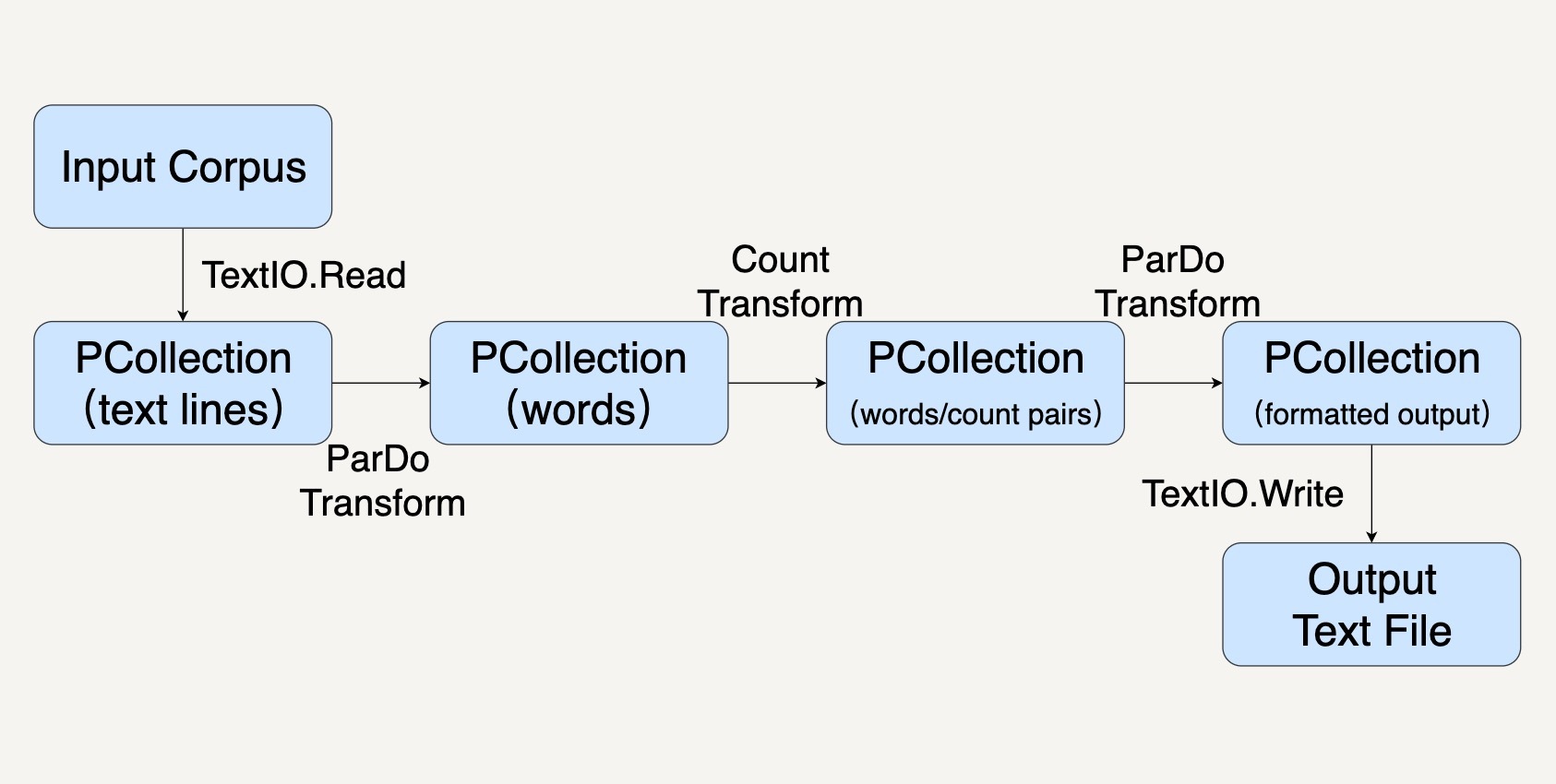31 WordCount Beam Pipeline实战 你好,我是蔡元楠。
今天我要与你分享的主题是“WordCount Beam Pipeline实战”。
前面我们已经学习了Beam的基础数据结构PCollection,基本数据转换操作Transform,还有Pipeline等技术。你一定跃跃欲试,想要在实际项目中使用了。这一讲我们就一起学习一下怎样用Beam解决数据处理领域的教科书级案例——WordCount。
WordCount你一定不陌生,在第18讲中,我们就已经接触过了。WordCount问题是起源于MapReduce时代就广泛使用的案例。顾名思义,WordCount想要解决的问题是统计一个文本库中的词频。
比如,你可以用WordCount找出莎士比亚最喜欢使用的单词,那么你的输入是莎士比亚全集,输出就是每个单词出现的次数。举个例子,比如这一段: HAMLET ACT I SCENE I Elsinore. A platform before the castle. [FRANCISCO at his post. Enter to him BERNARDO] BERNARDO Who’s there? FRANCISCO Nay, answer me: stand, and unfold yourself. BERNARDO Long live the king! FRANCISCO Bernardo? BERNARDO He. FRANCISCO You come most carefully upon your hour. BERNARDO ‘Tis now struck twelve; get thee to bed, Francisco. FRANCISCO For this relief much thanks: ‘tis bitter cold, And I am sick at heart. BERNARDO Have you had quiet guard? FRANCISCO Not a mouse stirring. BERNARDO Well, good night. If you do meet Horatio and Marcellus, The rivals of my watch, bid them make haste. FRANCISCO I think I hear them. Stand, ho! Who’s there?
在这个文本库中,我们用“the: 数字”表示the出现了几次,数字就是单词出现的次数。
The: 3 And: 3 Him: 1 …
那么我们怎样在Beam中处理这个问题呢?结合前面所学的知识,我们可以把Pipeline分为这样几步:
- 用Pipeline IO读取文本库(参考第27讲);
- 用Transform对文本进行分词和词频统计操作(参考第25讲);
- 用Pipeline IO输出结果(参考第27讲);
- 所有的步骤会被打包进一个Beam Pipeline(参考第26讲)。
整个过程就如同下图所示。

创建Pipeline
首先,我们先用代码创建一个PipelineOptions的实例。PipelineOptions能够让我们对Pipeline进行必要的配置,比如配置执行程序的Runner,和Runner所需要的参数。我们在这里先采用默认配置。
记得第30讲中我们讲过,Beam Pipeline可以配置在不同的Runner上跑,比如SparkRunner,FlinkRunner。如果PipelineOptions不配置的情况下,默认的就是DirectRunner,也就是说会在本机执行。
Java PipelineOptions options = PipelineOptionsFactory.create();
接下来,我们就可以用这个PipelineOptions去创建一个Pipeline了。一个Pipeline实例会去构建一个数据处理流水线所需要的数据处理DAG,以及这个DAG所需要进行的Transform。
Java Pipeline p = Pipeline.create(options);
应用Transform
在上面的设计框图中,我们可以看到,我们需要进行好几种Transform。比如TextIO.Read、ParDo、Count去读取数据,操纵数据,以及存储数据。
每一种Transform都需要一些参数,并且会输出特定的数据。输入和输出往往会用PCollection的数据结构表示。简单回顾一下,PCollection是Beam对于数据集的抽象,表示任意大小、无序的数据,甚至可以是无边界的Streaming数据。
在我们这个WordCount例子中,我们的Transform依次是这样几个。
第一个Transform,是先要用TextIO.Read来读取一个外部的莎士比亚文集,生成一个PCollection,包含这个文集里的所有文本行。这个PCollection中的每个元素都是文本中的一行。
Java
PCollection
第二个Transform,我们要把文本行中的单词提取出来,也就是做分词(tokenization)。
这一步的输入PCollection中的每个元素都表示了一行。那么输出呢?输出还是一个PCollection,但是每个元素变成了单词。
你可以留意一下,我们这里做分词时,用的正则表达式[^\p{L}]+,意思是非Unicode Letters所以它会按空格或者标点符号等把词分开。
Java
PCollection
第三个Transform,我们就会使用Beam SDK提供的Count Transform。Count Transform会把任意一个PCollection转换成有key/value的组合,每一个key是原来PCollection中的非重复的元素,value则是元素出现的次数。
Java
PCollection<KV<String, Long» counts = words.apply(Count.
第四个Transform会把刚才的key/value组成的PCollection转换成我们想要的输出格式,方便我们输出词频。因为大部分的时候,我们都是想要把输出存储到另一个文件里的。
Java
PCollection
最后一个Transform就是TextIO.Write用来把最终的PCollection写进文本文档。PCollection中的每一个元素都会被写为文本文件中的独立一行。
运行Pipeline
调用Pipeline的run()方法会把这个Pipeline所包含的Transform优化并放到你指定的Runner上执行。这里你需要注意,run()方法是异步的,如果你想要同步等待Pipeline的执行结果,需要调用waitUntilFinish()方法。
Java p.run().waitUntilFinish();
改进代码的建议
代码看起来都完成了,不过,我们还可以对代码再做些改进。
编写独立的DoFn
在上面的示例代码中,我们把Transform都inline地写在了apply()方法里。
Java lines.apply(“ExtractWords”, FlatMapElements .into(TypeDescriptors.strings()) .via((String word) -> Arrays.asList(word.split(“[^\p{L}]+”))));
但是这样的写法在实际工作中很难维护。
一是因为真实的业务逻辑往往比较复杂,很难用一两行的代码写清楚,强行写成inline的话可读性非常糟糕。
二是因为这样inline的Transform几乎不可复用和测试。
所以,实际工作中,我们更多地会去继承DoFn来实现我们的数据操作。这样每个DoFn我们都可以单独复用和测试。
接下来,我们看看怎样用用DoFn来实现刚才的分词Transform?
其实很简单,我们继承DoFn作为我们的子类ExtracrtWordsFn,然后把单词的拆分放在DoFn的processElement成员函数里。
Java
static class ExtractWordsFn extends DoFn<String, String> { private final Counter emptyLines = Metrics.counter(ExtractWordsFn.class, “emptyLines”); private final Distribution lineLenDist = Metrics.distribution(ExtractWordsFn.class, “lineLenDistro”); @ProcessElement public void processElement(@Element String element, OutputReceiver
创建PTransform合并相关联的Transform
PTransform类可以用来整合一些相关联的Transform。
比如你有一些数据处理的操作包含几个Transform或者ParDo,你可以把他们封装在一个PTransform里。
我们这里试着把上面的ExtractWordsFn和Count两个Transform封装起来。这样可以对这样一整套数据处理操作复用和测试。当定义PTransform的子类时,它的输入输出类型就是一连串Transform的最初输入和最终输出。那么在这里,输入类型是String,输出类型是KV。就如同下面的代码一样。
Java
/// /* A PTransform that converts a PCollection containing lines of text into a PCollection of /* formatted word counts. /* /* <p>This is a custom composite transform that bundles two transforms (ParDo and /* Count) as a reusable PTransform subclass. Using composite transforms allows for easy reuse, /* modular testing, and an improved monitoring experience. /*/ public static class CountWords extends PTransform<PCollection
参数化PipelineOptions
刚才我们把输入文件的路径和输出文件的路径都写在了代码中。但实际工作中我们很少会这样做。
因为这些文件的路径往往是运行时才会决定,比如测试环境和生产环境会去操作不同的文件。在真正的实际工作中,我们往往把它们作为命令行参数放在PipelineOptions里面。这就需要去继承PipelineOptions。
比如,我们创建一个WordCountOptions,把输出文件作为参数output。
Java public static interface WordCountOptions extends PipelineOptions { @Description(“Path of the file to write to”) @Required String getOutput(); void setOutput(String value); }
完成上面两个方面的改进后,我们最终的数据处理代码会是这个样子:
Java public static void main(String[] args) { WordCountOptions options = PipelineOptionsFactory.fromArgs(args).withValidation().as(WordCountOptions.class); Pipeline p = Pipeline.create(options); p.apply(“ReadLines”, TextIO.read().from(options.getInputFile())) .apply(new CountWords()) .apply(ParDo.of(new FormatAsTextFn())) .apply(“WriteCounts”, TextIO.write().to(options.getOutput())); p.run().waitUntilFinish(); }
DoFn和PTransform的单元测试
如同第29讲“如何测试Pipeline”中所讲的那样,我们用PAssert测试Beam Pipeline。具体在我们这个例子中,我一再强调要把数据处理操作封装成DoFn和PTransform,因为它们可以独立地进行测试。
什么意思呢?比如,ExtractWordsFn我们想要测试它能把一个句子分拆出单词,比如“” some input words “,我们期待的输出是[“some”, “input”, “words”]。在测试中,我们可以这样表达: /// Example test that tests a specific {@link DoFn}. /*/ @Test public void testExtractWordsFn() throws Exception { DoFnTester<String, String> extractWordsFn = DoFnTester.of(new ExtractWordsFn()); Assert.assertThat( extractWordsFn.processBundle(“ some input words “), CoreMatchers.hasItems(“some”, “input”, “words”)); Assert.assertThat(extractWordsFn.processBundle(“ “), CoreMatchers.hasItems()); Assert.assertThat( extractWordsFn.processBundle(“ some “, “ input”, “ words”), CoreMatchers.hasItems(“some”, “input”, “words”)); }
小结
这一讲我们应用前面学习的PCollection,Pipeline,Pipeline IO,Transform知识去解决了一个数据处理领域经典的WordCount问题。并且学会了一些在实际工作中改进数据处理代码质量的贴士,比如写成单独可测试的DoFn,和把程序参数封装进PipelineOptions。
思考题
文中提供了分词的DoFn——ExtractWordsFn,你能利用相似的思路把输出文本的格式化写成一个DoFn吗?也就是文中的FormatAsTextFn,把PCollection> 转化成PCollection ,每一个元素都是 : 的格式。
欢迎你把答案写在留言区,与我和其他同学一起讨论。如果你觉得有所收获,也欢迎把文章分享给你的朋友。
参考资料
https://learn.lianglianglee.com/%e4%b8%93%e6%a0%8f/%e5%a4%a7%e8%a7%84%e6%a8%a1%e6%95%b0%e6%8d%ae%e5%a4%84%e7%90%86%e5%ae%9e%e6%88%98/31%20WordCount%20Beam%20Pipeline%e5%ae%9e%e6%88%98.md
更多学习
更多实时资讯,前沿技术,生活趣事。尽在【老马啸西风】
交流社群:[交流群信息](https://mp.weixin.qq.com/s/rkSvXxiiLGjl3S-ZOZCr0Q)
